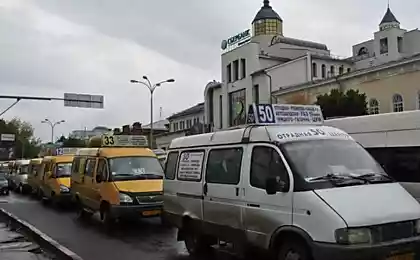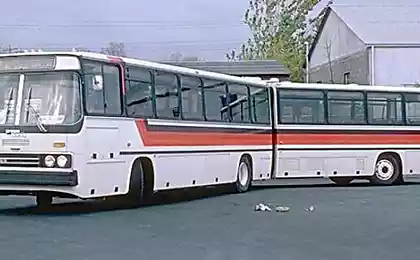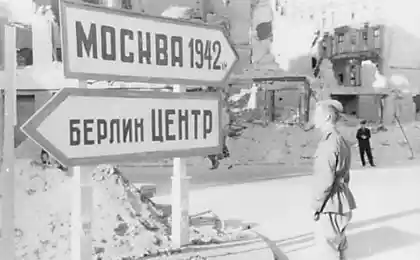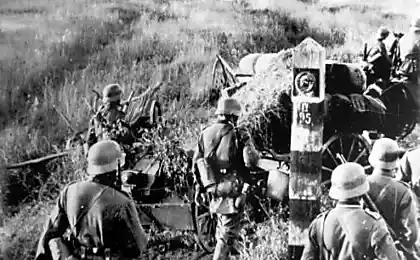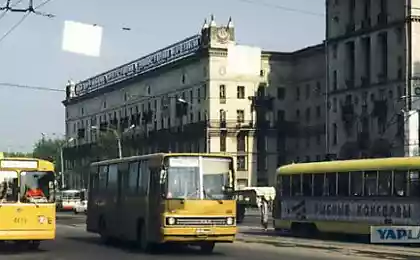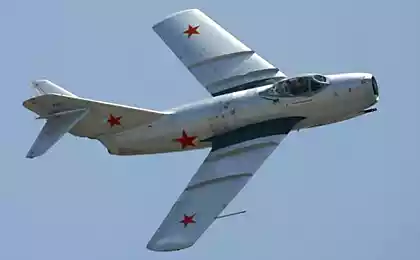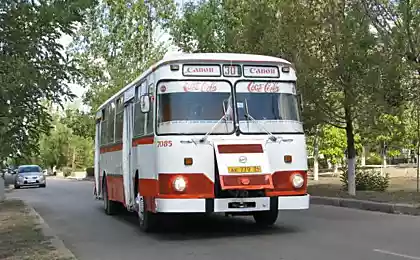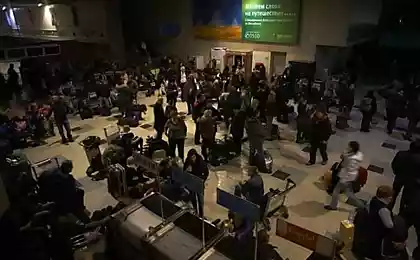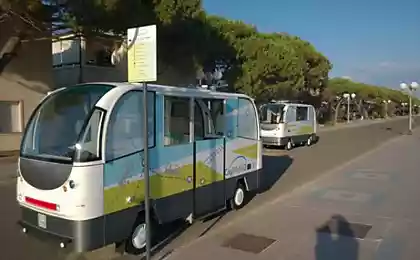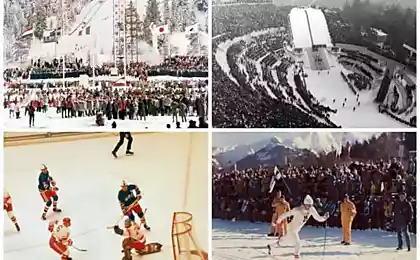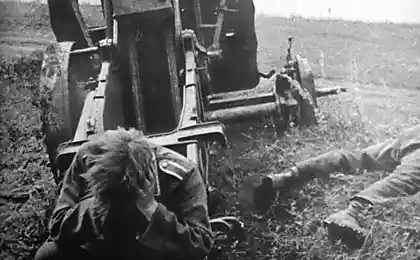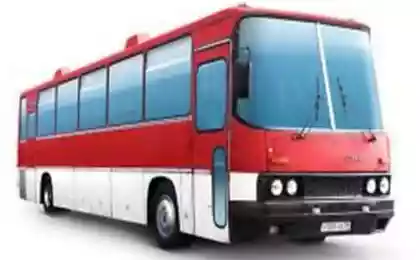2033
The Soviet buses
Was there an hour ago about the theme of the American coaches ... decided the answer lay, we can say is the status :)
It will be a lot of photons and letters, please do not break. Consider the most well-known and / or interesting bus to mid 80s release. I will try as much as possible to compress the Old, because if we describe in detail each - should be a day to sit at the computer and stretch the post page 40. If someone is interesting - ask in the comments, I will answer in detail
So, the story began with the Soviet bus bus-based AMO F-15.
The first bus with a capacity of 14 passengers AMO was founded in 1926 on the chassis 1, 5-ton truck AMO-F-15. The body was carried on a frame of bent wood profiles and lined with metal, the roof is covered with leatherette. The passenger door was one - in front of the rear wheel arch. The four-cylinder petrol engine capacity of 35 hp let the bus accelerates to 50 km / h. In addition, since 1927 it produced a two-door postal bus (rear door was behind the rear wheel arch) and ambulance (without side windows). The manufacturers put on the chassis of the AMO-F-15 and their own body, for example, open a canvas awning to service resorts. Picture postcard 1983:
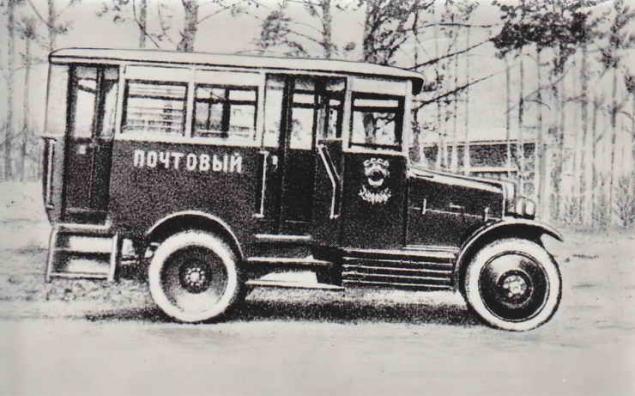
Later it appears elongated version - AMO 4 (1933). 22 seats. The maximum speed with a 6-cylinder engine of 60 hp It was 55 km / h. Produced was a party of several dozen cars.
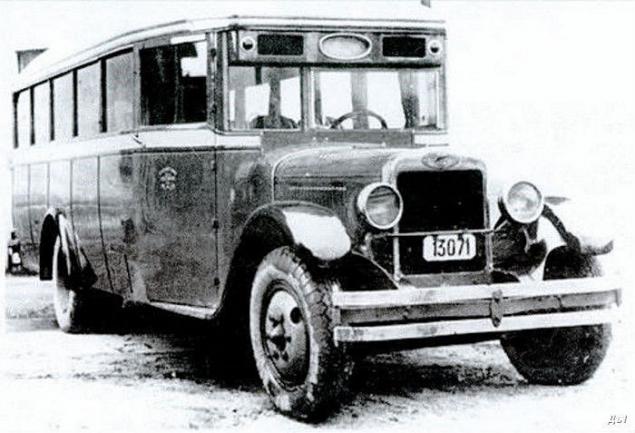
On the basis of ZIS-5, or rather its elongated at the base of 3, 81 and 4, 42 m chassis ZIS-11 in 1934-1936. issued 22-seater (the total number of seats 29) bus ZIS-8. The six-cylinder in-line engine carburetor of 5, 55 liters capacity of 73 hp ZIS-8 allowed full weight of 6, 1 ton accelerate to 60 km / h. On ZISe it produced only 547 units. ZIS-8.
Then brag - my photos, copyright
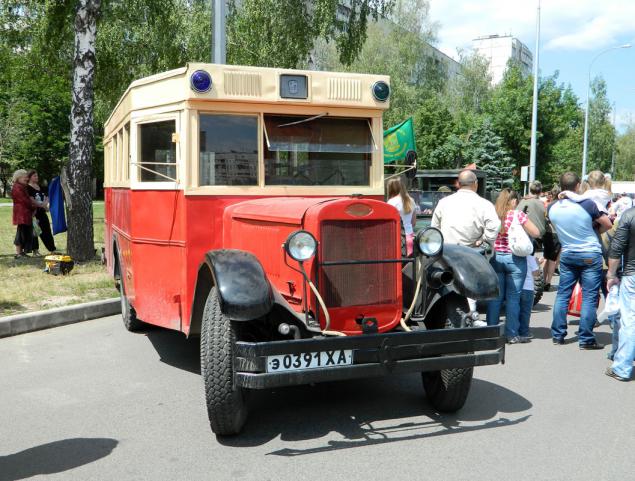
In 1938 ZIS-8 on the conveyor replaced more perfect keeping with the trends of the time ZIS-16.
Production of buses ZIS-16, which vary according to the then fashion automotive streamlined body, but still perform on a wooden frame, was deployed in 1938 and continued until August 1941. The bus seats up to 34 passengers (26 seats). Boosted to 84 hp ZIS-16 motor car accelerates full weight of 7, 13 m to 65 km / h
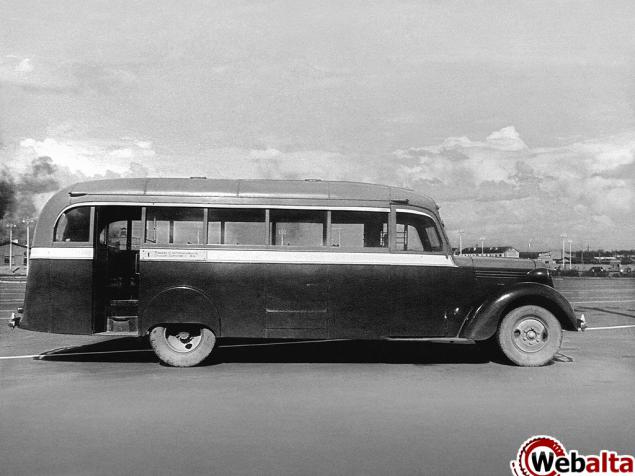
Release buses was resumed after the war, in 1946.
Then the body was designed, at the same time become MTV-82 tram, trolley-MTB-82 and ZIS-154 bus. ZIS-154 was not just a bus ... In 1946, domestic designers have managed to create a hybrid!
Construction of the bus was good for the domestic auto industry: the first otchechestvenny serial-metal monocoque wagon-type (by the way unified with trolley-MTB-82 and tram MTV-82) from the passenger door in the front overhang and the engine in the rear, pneumatic doors, adjustable in three direction the driver's seat, diesel and electric transmission with an electric generator and an electric motor. Forced diesel YAZ-204D 112 hp let the bus full weight of 12, 34 m to accelerate to 65 km / h. There were produced 1164 bus ZIS-154. However, only mastered while in the production of diesel appeared underdeveloped of exhaust smoke and reliability, so equipped them ZIS-154, who suffered also a whole bunch of "childhood diseases", became the object of serious complaints of citizens and the system owner, which led to a relatively rapid removal of the bus with production in 1950. One of them is preserved in the museum Mosgortrans

Replace the failed ZIS-154 has become easier to manufacture, but less roomy 8-meter ZIS-155 design which used body parts ZIS-154 units and truck ZIS-150. By the way, at the ZIS-155 it was the first time in the domestic auto industry embedded alternator. The bus could carry 50 passengers (28 seats). ZIS-124 engine 90 hp clocked machine GVW 9 9 m to 70 km / h. Total produced 21,741 bus ZIS-155, which remained the basic model of bus fleets of the capital and other major cities in the Soviet Union from the mid 50s to mid 60s.
Preserved in the museum Mosgortrans and also as monuments in some cities, and sheds some collective
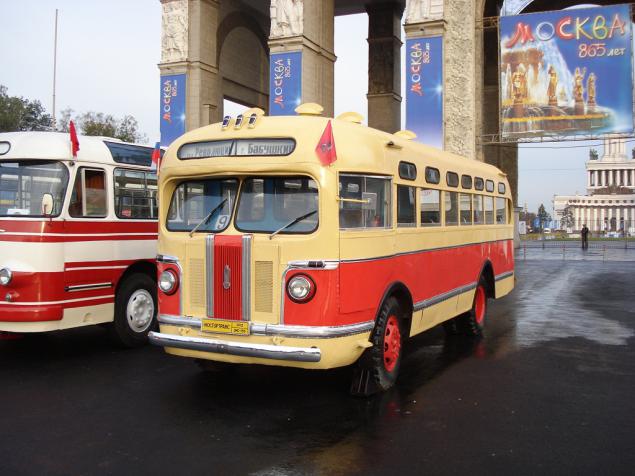
In 1955, for the first time in the Soviet Union developed a long-distance bus (before the car ZIS-155 running on the route Moscow - Yalta, scary to imagine how much and how it was to go ..)
The result was a huge luxury bus in the American style.

The bus with the original monocoque body length of 10, 22 m could carry 32 passengers, is located in the comfortable armchairs of aviation type tilt headrests and backrests. The power plant consisted of two-stroke diesel engine YAZ-206D, which was located along with the CPR cross in the back of the bus and drive the rear axle driveshaft angled to the longitudinal axis of the bus. The level and design the exterior and interior, passenger comfort and dynamic qualities of the ZIS (ZIL) -127 corresponds to the best foreign analogues and deservedly was the flagship of the domestic automotive industry. However, too much of the overall width of the ZIS-127 is 2, 68 m, exceeds international requirements (the width of the vehicle is not more than 2, 5 m) and an emphasis on the development of economic relations with the socialist countries members of CMEA, which was given priority in the production of buses of big class ( Hungary, Czechoslovakia) decided the fate of quite competitive models (in fact, the last competitive domestic bus) - in 1960 the production of ZIL-127 was minimized. A total of 1955-1960 years. produced 851 bus ZIS (ZIL) -127.
To this day in perfect condition ZIS-127 is preserved in a museum in Tallinn. More on the territory of the former USSR have several cars in a "shed in the backyard carpool»
It is interesting that on the basis of ZIL-127 in 1959, we have created and tested a gas turbine bus Turbo-US-053, has a top speed of 160 or more km / h. Turbine engine mounted in the rear developed 350 hp and it was half the weight of the base diesel YMZ-206D. However, in a series of such a machine due to the complexity in production and operation has not gone

ZIL-158, ZIL-158V - city bus. Produced from 1957 to 1959 on the ZIL and from 1959 to 1970 on the lyase. ZIL-158 model has been the main bus city bus parks in the Soviet Union in the 60's and early 70-ies of XX century.
It represents a further modernization of the bus ZIS-155. Notable lengthened by 770 mm body with increased up to 60 people. rated seating capacity (32 seats), redesigned front and rear masks, altered side windows, as well as engine with increased capacity by 9%. The first ZIL-158 had a window in ventilation hatches in the roof and the windows on the corners in the rear roof slopes.
Perednemotornaya layout was used, which subsequently migrated to LiAZ 677 and PAZ-652.
Sometimes the buses are still found ...
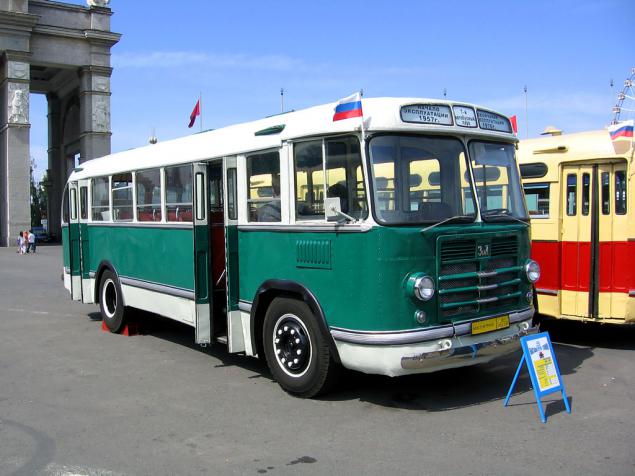
At the same time engaged in the production of buses in Lviv, in the factory, which used to be involved in the release of truck cranes and trailers.
LAZ-695. I think he needs no introduction ...
Initially it looked like. Huge windows in the ceiling (the far more early - tinted), an interesting behind the air intake on the roof. Rear-engined layout, the engine Zilovskoye. He began to produce more in 1956, since then repeatedly simplifies and transformed.

Appearance regularly simplifies changes hodovke for all the time production was rather small
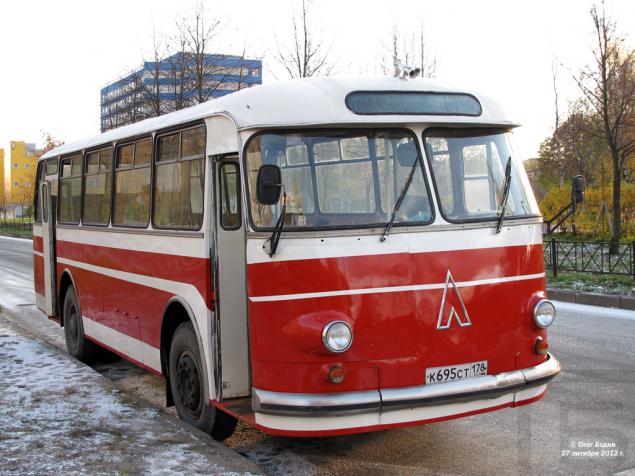
And in the end this turned into a 695 relatives and friends to all of us worker suburban routes, which was issued in 2002 right up to (and in fact - until 2010 !!!) years
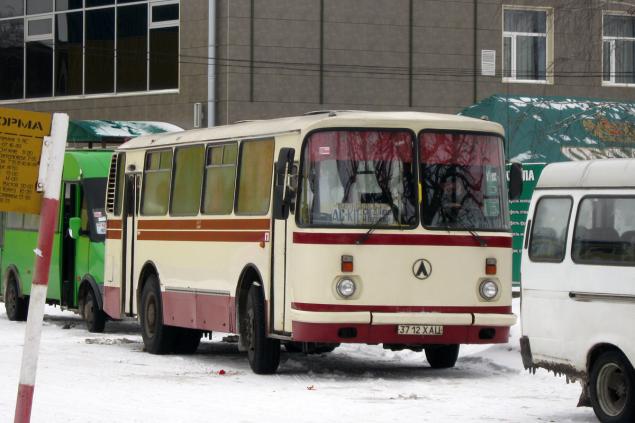
In the late '50s LAZ engaged in the development of long-distance buses. There were dozens of interesting options, they went into a series of units. For example, LAZ-697

In 1961 he was created a bus LAZ - Ukraine.
Remember "The Gas Station Queen". Learned?

In 1967 he was created a bus to make a real world breakthrough.
In the spring of 1967 the bus participated in the international competition of buses in Nice (XVIII International Bus Week), where he received the following awards:
- Prize of the President of France, two big differences prize and the Special Prize of the organizing committee - for taking part in the rally.
- Silver medal Bodybuilding - Competition bodies.
- Grand Prize and Cup organizing committee - for the technical tests.
- Big Cup - for the absolute first place on the skill of driving (driver - test engineer S.Borim).
Here's a she, "Ukraine-67»
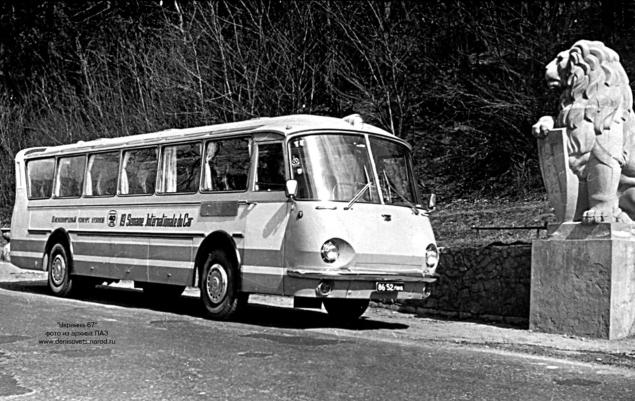
Returning to the lyase, which in 1962 began to produce the legend.
LiAZ 677. The warm, bubbling and swinging to an incredible amplitude familiar to almost anyone and needs no introduction ...
In some places they are still running, but in most cities has long melted "on katryuli»

There were many variants. for example, to the extreme north
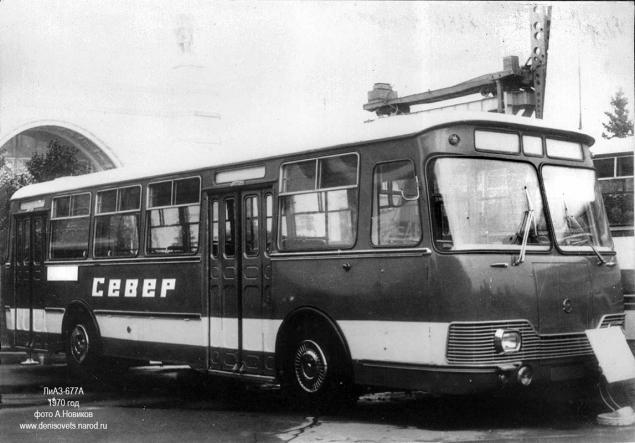
Meanwhile, engineers Ukravtobusproma prepared a surprise.
1970. The world's first low-floor bus. LAZ-360.
Collected two copies. First - LAZ360EM.
In 1970, when the creation of LAZ-360EM (some sources LAZ-360E), the main task of the designers was to lower the floor level of the bus to 360mm above the ground (hence the index bus - "360"). Make a low-floor bus was possible only abandoning the driveline, so trasmissiya to LAZ-360EM electromechanical. Bus engine (170 hp / 132kW) together with the electric front seats are placed (likely for the driver's seat), and the rear drive wheels were related to traction motors. A feature of the bus was tetraaxial chassis with small diameter tires. Two front axle driven, two rear top. Interesting was also the body with unusual art decision - Curved vertical windshields and trapezoidal side windows. The length of the bus was - 11.000mm.
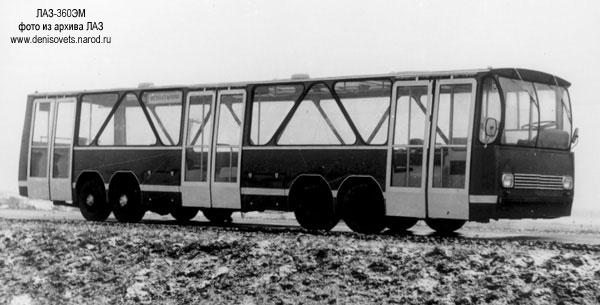
Some time later it became clear that the chosen chetyrehmostovaya electric transmission scheme was not justified, and then the design of the bus has been thoroughly revised and substantially redesigned. For an updated version was chosen biaxial scheme with his usual mechanical transmission, but with a front-wheel steering and - so there is an opportunity to make even low floor almost the entire length of the bus. The engine had a new bus also changed its position in the cabin - now he was on the right side of the driver. Also, change the number and location of the doors. Upgraded bus was named LAZ-360 (ie, low-floor, but without electromechanical transmission).
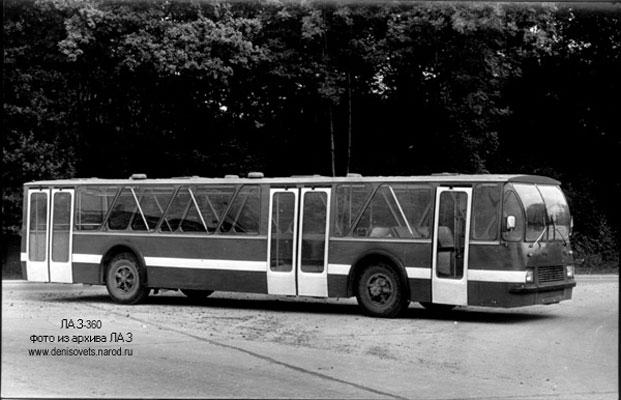
There have been other developments did not follow in the series. For example, LAZ-696 1966-1968 period. The first in the USSR and modern bus still common layout. Developments on it were used to build LiAZ 5256, LAZ-5252, and a dozen other buses late 80s
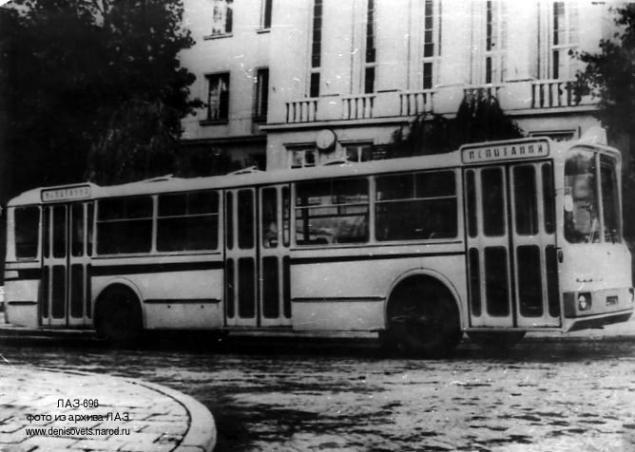
In 1973 he was created a bus Ukraine 73.
The level of the floor of the passenger compartment she was somewhat elevated relative to the driver's cab, which is why the bus became garret (common layout is now). Plus all the options 1971 in the "Ukraine-73" for the passengers appeared automatically opens the door (doors open outward, traveling in opposite directions), and air conditioning. It was planned that the bus and the engine will be a diesel YaMZ-740 (prototype for the diesel engine KAMAZ), but this engine is not got the bus, so we had to put a ZIL-375YA5.
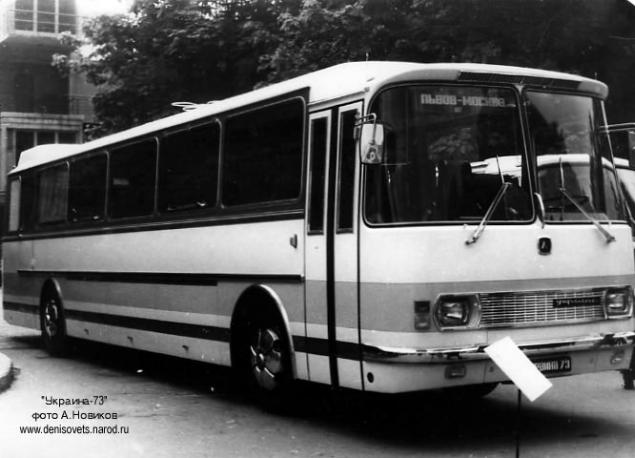
But in the '80s have finally begun to be installed on buses, diesel engines. such as LAZ-4202 was the engine KAMAZ-640. The first machines came with GMP "Lviv-3", but rather quickly adapted to the design of the suburb - Model 42021 has received a manual, and a clean city with the GMF 4202 and has remained a rare bird.
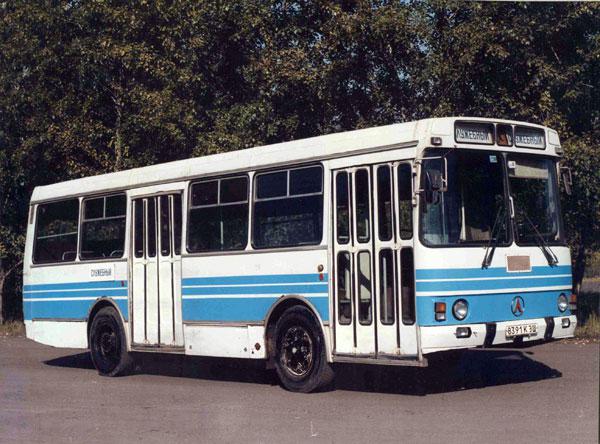
LiAZ 5256 ...
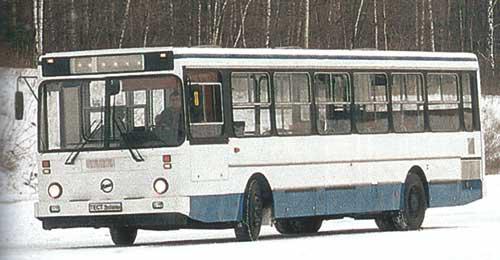
City, Intercity ... completely forgot about the connection between "urban-rural". Traditionally, buses of this group created on the principle of "take the truck GAZ-51 (or 53) and dress bus body»
Good old PAZ-652 (1958-1968)

PAZ-672 (1968-1989)

PAZ-3205 (1979, 1984, and commercially - from 1989 until now)

As well as all kinds of KAVZ
Posted in [mergetime] 1367622263 [/ mergetime]
Conclusion - pans and innovative ideas have been dozens. We are proud of our development kept pace with the times, and sometimes significantly outperforming it. But alas, in a series that went the cheaper and easier, and legacy buses were manufactured for decades without any major upgrades.
But our buses are reliable and survivable. And Rodney. And peace. In general, I have everything.
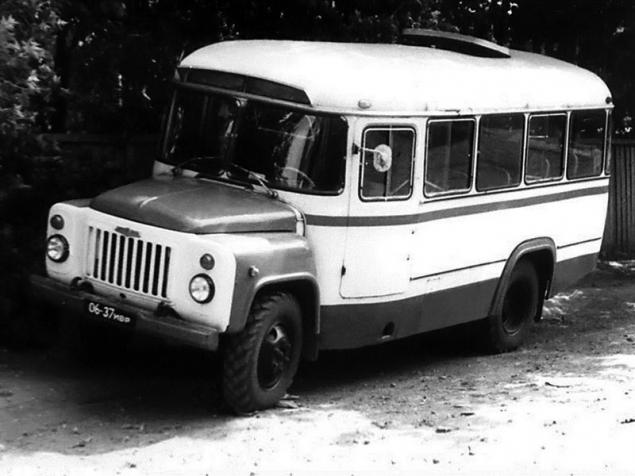
Source:
It will be a lot of photons and letters, please do not break. Consider the most well-known and / or interesting bus to mid 80s release. I will try as much as possible to compress the Old, because if we describe in detail each - should be a day to sit at the computer and stretch the post page 40. If someone is interesting - ask in the comments, I will answer in detail
So, the story began with the Soviet bus bus-based AMO F-15.
The first bus with a capacity of 14 passengers AMO was founded in 1926 on the chassis 1, 5-ton truck AMO-F-15. The body was carried on a frame of bent wood profiles and lined with metal, the roof is covered with leatherette. The passenger door was one - in front of the rear wheel arch. The four-cylinder petrol engine capacity of 35 hp let the bus accelerates to 50 km / h. In addition, since 1927 it produced a two-door postal bus (rear door was behind the rear wheel arch) and ambulance (without side windows). The manufacturers put on the chassis of the AMO-F-15 and their own body, for example, open a canvas awning to service resorts. Picture postcard 1983:

Later it appears elongated version - AMO 4 (1933). 22 seats. The maximum speed with a 6-cylinder engine of 60 hp It was 55 km / h. Produced was a party of several dozen cars.

On the basis of ZIS-5, or rather its elongated at the base of 3, 81 and 4, 42 m chassis ZIS-11 in 1934-1936. issued 22-seater (the total number of seats 29) bus ZIS-8. The six-cylinder in-line engine carburetor of 5, 55 liters capacity of 73 hp ZIS-8 allowed full weight of 6, 1 ton accelerate to 60 km / h. On ZISe it produced only 547 units. ZIS-8.
Then brag - my photos, copyright

In 1938 ZIS-8 on the conveyor replaced more perfect keeping with the trends of the time ZIS-16.
Production of buses ZIS-16, which vary according to the then fashion automotive streamlined body, but still perform on a wooden frame, was deployed in 1938 and continued until August 1941. The bus seats up to 34 passengers (26 seats). Boosted to 84 hp ZIS-16 motor car accelerates full weight of 7, 13 m to 65 km / h

Release buses was resumed after the war, in 1946.
Then the body was designed, at the same time become MTV-82 tram, trolley-MTB-82 and ZIS-154 bus. ZIS-154 was not just a bus ... In 1946, domestic designers have managed to create a hybrid!
Construction of the bus was good for the domestic auto industry: the first otchechestvenny serial-metal monocoque wagon-type (by the way unified with trolley-MTB-82 and tram MTV-82) from the passenger door in the front overhang and the engine in the rear, pneumatic doors, adjustable in three direction the driver's seat, diesel and electric transmission with an electric generator and an electric motor. Forced diesel YAZ-204D 112 hp let the bus full weight of 12, 34 m to accelerate to 65 km / h. There were produced 1164 bus ZIS-154. However, only mastered while in the production of diesel appeared underdeveloped of exhaust smoke and reliability, so equipped them ZIS-154, who suffered also a whole bunch of "childhood diseases", became the object of serious complaints of citizens and the system owner, which led to a relatively rapid removal of the bus with production in 1950. One of them is preserved in the museum Mosgortrans

Replace the failed ZIS-154 has become easier to manufacture, but less roomy 8-meter ZIS-155 design which used body parts ZIS-154 units and truck ZIS-150. By the way, at the ZIS-155 it was the first time in the domestic auto industry embedded alternator. The bus could carry 50 passengers (28 seats). ZIS-124 engine 90 hp clocked machine GVW 9 9 m to 70 km / h. Total produced 21,741 bus ZIS-155, which remained the basic model of bus fleets of the capital and other major cities in the Soviet Union from the mid 50s to mid 60s.
Preserved in the museum Mosgortrans and also as monuments in some cities, and sheds some collective

In 1955, for the first time in the Soviet Union developed a long-distance bus (before the car ZIS-155 running on the route Moscow - Yalta, scary to imagine how much and how it was to go ..)
The result was a huge luxury bus in the American style.

The bus with the original monocoque body length of 10, 22 m could carry 32 passengers, is located in the comfortable armchairs of aviation type tilt headrests and backrests. The power plant consisted of two-stroke diesel engine YAZ-206D, which was located along with the CPR cross in the back of the bus and drive the rear axle driveshaft angled to the longitudinal axis of the bus. The level and design the exterior and interior, passenger comfort and dynamic qualities of the ZIS (ZIL) -127 corresponds to the best foreign analogues and deservedly was the flagship of the domestic automotive industry. However, too much of the overall width of the ZIS-127 is 2, 68 m, exceeds international requirements (the width of the vehicle is not more than 2, 5 m) and an emphasis on the development of economic relations with the socialist countries members of CMEA, which was given priority in the production of buses of big class ( Hungary, Czechoslovakia) decided the fate of quite competitive models (in fact, the last competitive domestic bus) - in 1960 the production of ZIL-127 was minimized. A total of 1955-1960 years. produced 851 bus ZIS (ZIL) -127.
To this day in perfect condition ZIS-127 is preserved in a museum in Tallinn. More on the territory of the former USSR have several cars in a "shed in the backyard carpool»
It is interesting that on the basis of ZIL-127 in 1959, we have created and tested a gas turbine bus Turbo-US-053, has a top speed of 160 or more km / h. Turbine engine mounted in the rear developed 350 hp and it was half the weight of the base diesel YMZ-206D. However, in a series of such a machine due to the complexity in production and operation has not gone

ZIL-158, ZIL-158V - city bus. Produced from 1957 to 1959 on the ZIL and from 1959 to 1970 on the lyase. ZIL-158 model has been the main bus city bus parks in the Soviet Union in the 60's and early 70-ies of XX century.
It represents a further modernization of the bus ZIS-155. Notable lengthened by 770 mm body with increased up to 60 people. rated seating capacity (32 seats), redesigned front and rear masks, altered side windows, as well as engine with increased capacity by 9%. The first ZIL-158 had a window in ventilation hatches in the roof and the windows on the corners in the rear roof slopes.
Perednemotornaya layout was used, which subsequently migrated to LiAZ 677 and PAZ-652.
Sometimes the buses are still found ...

At the same time engaged in the production of buses in Lviv, in the factory, which used to be involved in the release of truck cranes and trailers.
LAZ-695. I think he needs no introduction ...
Initially it looked like. Huge windows in the ceiling (the far more early - tinted), an interesting behind the air intake on the roof. Rear-engined layout, the engine Zilovskoye. He began to produce more in 1956, since then repeatedly simplifies and transformed.

Appearance regularly simplifies changes hodovke for all the time production was rather small

And in the end this turned into a 695 relatives and friends to all of us worker suburban routes, which was issued in 2002 right up to (and in fact - until 2010 !!!) years

In the late '50s LAZ engaged in the development of long-distance buses. There were dozens of interesting options, they went into a series of units. For example, LAZ-697

In 1961 he was created a bus LAZ - Ukraine.
Remember "The Gas Station Queen". Learned?

In 1967 he was created a bus to make a real world breakthrough.
In the spring of 1967 the bus participated in the international competition of buses in Nice (XVIII International Bus Week), where he received the following awards:
- Prize of the President of France, two big differences prize and the Special Prize of the organizing committee - for taking part in the rally.
- Silver medal Bodybuilding - Competition bodies.
- Grand Prize and Cup organizing committee - for the technical tests.
- Big Cup - for the absolute first place on the skill of driving (driver - test engineer S.Borim).
Here's a she, "Ukraine-67»

Returning to the lyase, which in 1962 began to produce the legend.
LiAZ 677. The warm, bubbling and swinging to an incredible amplitude familiar to almost anyone and needs no introduction ...
In some places they are still running, but in most cities has long melted "on katryuli»

There were many variants. for example, to the extreme north

Meanwhile, engineers Ukravtobusproma prepared a surprise.
1970. The world's first low-floor bus. LAZ-360.
Collected two copies. First - LAZ360EM.
In 1970, when the creation of LAZ-360EM (some sources LAZ-360E), the main task of the designers was to lower the floor level of the bus to 360mm above the ground (hence the index bus - "360"). Make a low-floor bus was possible only abandoning the driveline, so trasmissiya to LAZ-360EM electromechanical. Bus engine (170 hp / 132kW) together with the electric front seats are placed (likely for the driver's seat), and the rear drive wheels were related to traction motors. A feature of the bus was tetraaxial chassis with small diameter tires. Two front axle driven, two rear top. Interesting was also the body with unusual art decision - Curved vertical windshields and trapezoidal side windows. The length of the bus was - 11.000mm.

Some time later it became clear that the chosen chetyrehmostovaya electric transmission scheme was not justified, and then the design of the bus has been thoroughly revised and substantially redesigned. For an updated version was chosen biaxial scheme with his usual mechanical transmission, but with a front-wheel steering and - so there is an opportunity to make even low floor almost the entire length of the bus. The engine had a new bus also changed its position in the cabin - now he was on the right side of the driver. Also, change the number and location of the doors. Upgraded bus was named LAZ-360 (ie, low-floor, but without electromechanical transmission).

There have been other developments did not follow in the series. For example, LAZ-696 1966-1968 period. The first in the USSR and modern bus still common layout. Developments on it were used to build LiAZ 5256, LAZ-5252, and a dozen other buses late 80s

In 1973 he was created a bus Ukraine 73.
The level of the floor of the passenger compartment she was somewhat elevated relative to the driver's cab, which is why the bus became garret (common layout is now). Plus all the options 1971 in the "Ukraine-73" for the passengers appeared automatically opens the door (doors open outward, traveling in opposite directions), and air conditioning. It was planned that the bus and the engine will be a diesel YaMZ-740 (prototype for the diesel engine KAMAZ), but this engine is not got the bus, so we had to put a ZIL-375YA5.

But in the '80s have finally begun to be installed on buses, diesel engines. such as LAZ-4202 was the engine KAMAZ-640. The first machines came with GMP "Lviv-3", but rather quickly adapted to the design of the suburb - Model 42021 has received a manual, and a clean city with the GMF 4202 and has remained a rare bird.

LiAZ 5256 ...

City, Intercity ... completely forgot about the connection between "urban-rural". Traditionally, buses of this group created on the principle of "take the truck GAZ-51 (or 53) and dress bus body»
Good old PAZ-652 (1958-1968)

PAZ-672 (1968-1989)

PAZ-3205 (1979, 1984, and commercially - from 1989 until now)

As well as all kinds of KAVZ
Posted in [mergetime] 1367622263 [/ mergetime]
Conclusion - pans and innovative ideas have been dozens. We are proud of our development kept pace with the times, and sometimes significantly outperforming it. But alas, in a series that went the cheaper and easier, and legacy buses were manufactured for decades without any major upgrades.
But our buses are reliable and survivable. And Rodney. And peace. In general, I have everything.

Source:
